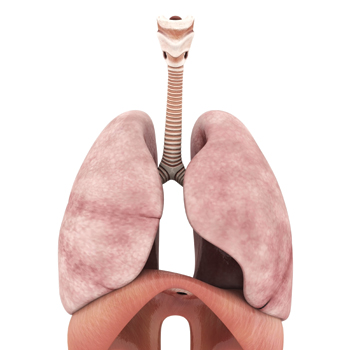Catch up on new COPD guidelines
Updated guidelines for chronic obstructive pulmonary disease revised the definition and staging of the condition, and an expert offers tips for optimal care.
Internists know they see a lot of patients with chronic obstructive pulmonary disease (COPD), but they might not realize quite how many.
“It's estimated that more than 50% of patients with reduced lung function are actually unaware of the diagnosis,” Josalyn L. Cho, MD, told attendees at Hospital Medicine 2018, held April 8-11 in Orlando, Fla. “I think it's important to recognize that symptoms, and even exacerbations resulting in hospitalization, can occur before the onset of airway obstruction.”

It's also important to stay on top of the guidelines for the condition, which were updated last year by the Global Initiative for Chronic Obstructive Lung Disease (GOLD). Dr. Cho, a pulmonologist at Massachusetts General Hospital in Boston, reviewed the updated guidelines and the research on which they were based, as well as offering some of her own tips on optimal COPD care.
“Part of the update this year was to redefine the definition of the disease,” she said, noting that COPD is defined as persistent respiratory symptoms that occur in the setting of airflow limitation, which is defined as a post-bronchodilator forced expiratory volume in one second (FEV1) to forced vital capacity (FVC) ratio of less than 70%, and may be related to either airway or alveolar abnormalities.
The guidelines also revised the staging of COPD. “What they did in the most recent update is to separate the severity of airflow obstruction as measured by spirometry from the patient's exacerbation history and the nature and magnitude of their symptoms,” said Dr. Cho. Spirometry results are used to classify patients as stage 1, 2, 3, or 4.
Then symptoms and exacerbation history are used to select a letter classification: A, B, C, or D. Classes A and B are those patients with one or no exacerbations and no hospital admissions. Patients in classes C and D have had at least two exacerbations or an admission and are differentiated by the severity of their symptoms (D being more severe than C).
“The most common symptom far and away is breathlessness, and you have to push your patients sometimes to acknowledge this, as most commonly they'll just sort of decrease their level of peak activity,” said Dr. Cho. “It's also important to ask about ways in which the disease limits their life, their daily activities, ability to leave the house, disrupts their sleep, and also whether they have chronic cough and mucus production.”
To assess symptoms, the guidelines recommend using the modified Medical Research Council scale or the COPD Assessment Test, and Dr. Cho favors the latter. Don't forget to also identify and treat comorbidities, which commonly include cardiovascular disease, skeletal muscle dysfunction, metabolic syndrome, osteoporosis, depression and anxiety, and lung cancer, she said.
“About 70% of COPD patients have at least one comorbidity, and 30% have four or more comorbidities,” Dr. Cho reported.
Comorbidities are associated with worse outcomes, as are exacerbations themselves. “Every time I see these numbers I find them surprising. But the five-year mortality rate after an acute exacerbation of COPD is 50%,” Dr. Cho said, citing a 2005 study published in Thorax.
Particularly in patients with comorbidities, it's important to confirm that a COPD exacerbation is in fact the correct diagnosis. “I will particularly draw your attention to exacerbations of congestive heart failure, because these are underdiagnosed in the population of patients who have COPD and should be carefully looked for,” she said. Other conditions for the differential include pulmonary thromboembolism, pneumonia, and pneumothorax.
The hunt for a cause of a patient's symptoms may well turn up a viral infection. “Up to 80% of exacerbations of COPD are due to infection,” said Dr. Cho. “Bacterial infections also trigger acute exacerbations and are thought to play a role in about half of patients.”
Bacterial infection should be suspected in patients with GOLD stage 3 or 4 and sputum purulence. “If you look in the literature, sputum purulence is a subjective measure, usually reported by patients and defined as yellow or green sputum, but it turns out to have a very good sensitivity and specificity, of about 90% and 75%, respectively,” said Dr. Cho.
Culturing the sputum is recommended in patients at risk for Pseudomonas infection, patients with acute respiratory failure, and patients who don't respond to initial empiric antibiotics. “I would caution you about interpretation of results for that last group of patients, as those cultures may certainly be affected by prior antibiotics, and you should probably be thinking more broadly about other potential etiologies for the patients' symptoms if they're not responding to appropriate therapy,” said Dr. Cho.
If it's flu season, consider testing for that, too. “The [influenza polymerase-chain reaction] test is very specific, it has a greater than 90% specificity, but it's not entirely sensitive, so if you have influenza present in the community, and a high pretest probability, you should probably consider treating even if the test is negative,” said Dr. Cho.
Standard tests for a COPD exacerbation also include oxygen saturation, chest imaging, and an electrocardiogram. “You can consider individual tests like troponin, brain natriuretic peptide, or D-dimer based on the individual patient characteristics,” she said. “I would advocate that arterial blood gases should be obtained for most patients.”
Inpatient treatment consists of inhaled bronchodilators, corticosteroids, antibiotics, and respiratory support. “Treatment for patients hospitalized with COPD includes what it has included for many years. They are no groundbreaking updates here,” said Dr. Cho.
She did offer some specific tips on implementation of the usual therapies, though. “The data showing the benefit for oxygen in exacerbations of COPD are specifically around active titration of oxygen, so you can't just turn it on and walk away. You have to titrate it to specific saturation goals and to avoid hypercarbia.” The use of noninvasive ventilation for patients with signs of respiratory failure is supported by multiple trials, she noted.
On the other hand, there's little good evidence to support antibiotics, with past research having failed to use placebos or to adequately exclude pneumonia.
“The use of antibiotics in acute exacerbations of COPD remains controversial, and that's because of limitations in the quality of evidence that we have,” Dr. Cho said. “Nevertheless, the recommendation from GOLD is that antibiotics for a duration of five to seven days be given to patients who either have a severe exacerbation requiring mechanical ventilation or have a moderate to severe exacerbation with sputum purulence and either increased dyspnea or increased sputum volume. I imagine that's most of the patients that end up in your hospital.”
Concern about overuse of antibiotics has led to interest in procalcitonin-guided therapy, although Dr. Cho's hospital does not get results back fast enough to be useful, she noted.
Overuse is also an issue with corticosteroid therapy. “The mistake we see most at our institution [is] patients coming up with whopping doses of IV steroids. The data say that you only need 40 mg of prednisone daily for five to seven days, so short-course, moderate-dose prednisone,” Dr. Cho recommended.
She offered another treatment pearl on bronchodilators: Use nebulizers. “There's no difference in improvement in FEV1 when the medication is delivered via an inhaler versus a nebulizer, but I'd say it's pretty rare to have a patient admitted with a COPD exacerbation who has the strength and coordination and can hold their breath adequately enough to use an inhaler.”
Once you've successfully treated the patient, it's time to start worrying about readmission risk. “We know that 20% of patients who are admitted with an acute exacerbation of COPD will require rehospitalization within 30 days,” said Dr. Cho, noting that the most common readmission diagnoses are COPD, pneumonia, and congestive heart failure.
“It's particularly interesting that they come back in with COPD,” she said. “Twenty percent of patients won't recover their baseline lung function up to eight weeks after their exacerbation, and so part of readmissions may be that the patient's disease is still not well controlled, and they still haven't returned to baseline, and it's appropriate for them to be back in the hospital.”
However, there are some steps that physicians can take to try to combat readmissions. “Probably the most important is smoking cessation counseling,” Dr. Cho said. “Even three-minute counseling sessions have a significant impact on increasing the quit rate for smokers, so this should be performed for all patients with COPD who are current smokers.” Flu and pneumococcal vaccines are also indicated.
Patient and family education may help. “Self-management is all the rage and has been shown to decrease hospitalizations and emergency department visits. The problem, of course, is that every study that looks at this does self-management a little bit differently,” said Dr. Cho. Key points to cover include when to withdraw acute medications, what long-term medications are indicated, and how to use an inhaler, she advised.
Referral to pulmonary rehabilitation is something to consider, and early postdischarge follow-up is a must. “One thing that we find in our own patients that we could do better is optimizing the medications for the treatment of COPD, once the patient is an outpatient. That's actually critical, because there's a lot of good data that optimal medical management of outpatient COPD reduces exacerbations,” Dr. Cho said.
She reviewed the protocol for escalation of COPD medication regimens, from long-acting muscarinic antagonists alone to combination therapy, noting that recommendations differ depending on whether patients have class C or D disease and caution against steroids as first-line therapy.
“Treatment with inhaled corticosteroids alone is not recommended,” she said. “They are associated with a number of adverse effects. … This is the opposite of asthma.”
Caution is also in order when patients have found insufficient relief on combined therapies. “If you get a triple-therapy patient, which I'm sure many of you do, who continues to exacerbate, I would strongly encourage you to get a pulmonologist to consult on that patient,” Dr. Cho said.
Subspecialists won't have all the answers to keeping patients out of the hospital, but the effort must continue. “There is very little evidence to guide either physicians or health care systems in how we can actually do better at decreasing COPD readmission rates,” Dr. Cho said. “Nevertheless, we should try to focus on the readmissions that are preventable, and in particular, there's a lot of interest around variation in health care delivery and how we can do better with that.”





